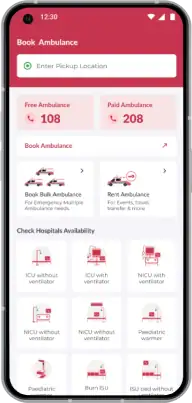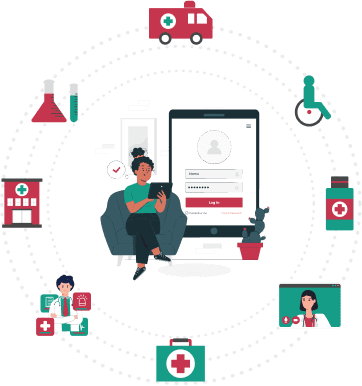Ambulances have an important role in providing timely medical assistance during emergencies. However, in India, the functioning of ambulances is plagued by numerous challenges. In this blog, we will shed light on the problems faced by ambulances in India.
Major Challenges Faced by Ambulances in India
Lack of Infrastructure and Accessibility
In India, ambulance services face an uphill battle due to the lack of adequate infrastructure and accessibility. Also, the number of ambulances often falls short to meet the demands of the growing population. Due to this uneven distribution, the population of rural areas suffer the most. Furthermore, inadequate road infrastructure and traffic congestion also delay the ambulances to reach the ones in need.
Delayed Response Time
The time an ambulance takes to reach the scene of an emergency quickly can make the difference between life and death. However, ambulances find it hard to navigate through the congested roads and traffic in India. Additionally, inefficient emergency call systems and dispatch services contribute to delayed response times. This lack of coordination among different stakeholders involved in emergency response exacerbates the problem.
Poor Maintenance and Equipment Shortages
Ambulances require regular maintenance to operate optimally. However, the lack of proper maintenance and repair services lead ambulances to breakdowns and compromised functionality. Moreover, shortages of essential medical equipment and supplies in ambulances hinder the delivery of quality care. And, the absence of reliable facilities for restocking and quality control further exacerbates the issue.
Financial Constraints and Funding Issues
Financial constraints are another significant challenge faced by ambulance services in India. Allocation of limited healthcare budgets often leaves ambulance services underfunded. The high operational costs, including fuel, maintenance, and staff salaries, further put a strain on the available funds.
Government Initiatives and Solutions
The government plays an important role in addressing the problems faced by ambulances. Several initiatives have been introduced to improve ambulance services across the country. However, more comprehensive policy reforms and regulations are needed to tackle the existing issues effectively. Learning from successful models and best practices in other countries can provide valuable insights.
Role of Technology in Enhancing Ambulance Services
In today's digital era, technology is becoming a game-changer in various industries, and the healthcare industry is no different. And it holds immense potential to revolutionise and enhance emergency medical services in India. Let's explore the role of technology in improving ambulance services and the benefits it can bring to the healthcare sector.
1. Integration in emergency call and dispatch services
Traditionally, emergency calls were made through phone lines, which often led to delays and miscommunications. However, now the response time has been significantly reduced by integrating technology into emergency call systems. Implementing a dedicated emergency helpline number, such as 108 or 102, has further simplified the process of connecting individuals in need with the appropriate emergency services. Additionally, digital platforms and mobile applications provide a more efficient way for people to request emergency medical assistance, allowing for quicker response and accurate information sharing.
2. Telemedicine and remote monitoring
Telemedicine involves the use of telecommunications technology for remote diagnosis and treatment. Equipping ambulances with telemedicine capabilities can significantly benefit ambulance services. It allows medical professionals to assess and guide emergency medical technicians in real time. This is quite helpful in providing immediate support and making critical decisions before the patient reaches the hospital. Furthermore, remote monitoring devices and wearable sensors help transmit vital signs and other relevant data to healthcare professionals. This further enables them to monitor patients' conditions remotely and make informed decisions about the patients’ health.
3. GPS tracking and Real-time data
Navigating through the traffic to find the best route and reaching the emergency scene on time is the most challenging for ambulance services. To address this challenge, ambulance services can utilise GPS tracking systems. This will help them access real time traffic information and identify the fastest routes to reach their destination. As a result, it reduces response times and also ensures that ambulances can avoid traffic congestion and reach the patient promptly. Moreover, the use of real-time data can help emergency services monitor and analyse response patterns. This can further help them strategically position ambulances in areas with higher demand and improve overall operational efficiency.
Benefit of Integrating Technology in Ambulance Services
- Faster response times
The integration of technology is streamlining the emergency call process by providing quick dispatch. It further leads to reduced response times and improved chances of saving lives.
- Enhanced pre-hospital care
Telemedicine and remote monitoring capabilities are helping healthcare professionals to provide advanced care even before the patient reaches the hospital. This helps in improving the overall patients’ health outcomes.
- Optimal resource utilisation
GPS tracking and real-time data are further allowing ambulance services to deploy vehicles strategically. This ensures efficient resource allocation and coverage of high-demand areas.
- Improved coordination
Technology is also helping in establishing seamless communication and coordination between emergency medical technicians, paramedics, hospitals, and other stakeholders. This results in a more effective emergency response. To know more about emergency ambulance services, check out the official website of MedCab or download our app from the app store (available for both Android and iPhone).






